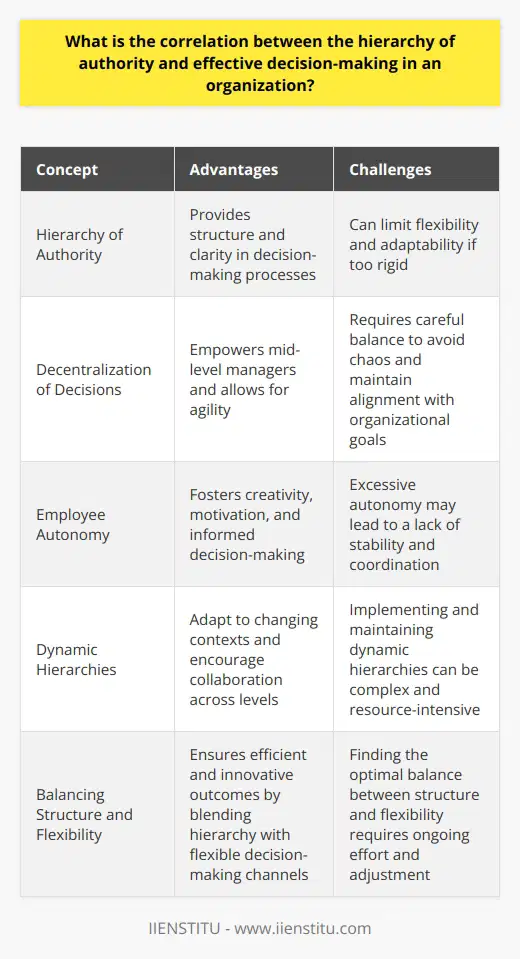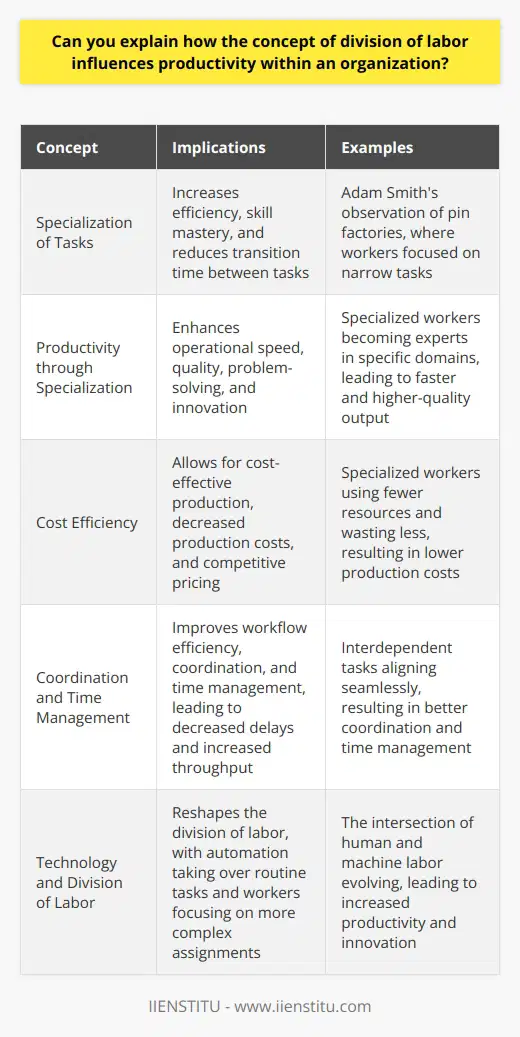
The intricate dance of managing a successful organization involves much more than a mere understanding of profit and loss statements or the abstract grasp of market forces. At its very core lies a complex network of principles, ranging from organizational structure and management principles to the more nuanced realms of leadership concepts and organizational efficiency.
This article aims to dissect these fundamental elements, exploring how they interconnect to form the scaffold of prosperous business entities. Whether it's a multinational corporation or a fledgling startup, these components remain crucial for the seamless operation and growth of a business. We also underscore the increasing relevance of mba programs and online certification courses in fostering a deeper understanding of these topics among professionals.
Organizational Structure: Building the Backbone of Business
An organization's structure is a defining factor of its operating paradigm, dictating how objectives are achieved, how authority is distributed, and how information flows among different levels of the organization. While definitive in scope, organizational structures remain dynamic, adapting to the strategic demands of the business landscape.
Hierarchical Structure: A hierarchical structure is akin to a pyramid featured prominently in both ancient and contemporary narratives of organization. Its tiers of authority create a clear, vertical chain of command from the top echelons to the frontline employees. This traditional format offers the benefits of a well-defined organizational chart, with clear job roles and responsibilities, which in principle lead to simplified decision-making and accountability. However, it's not without its downsides, including the risk of bureaucratization and slower response times to market changes.
Flat or Horizontal Structure: Turning the pyramid on its side, we encounter a flat or horizontal structure where layers of middle management are reduced, fostering direct pathways of communication between staff and leaders. This structure promotes autonomy and quick decision-making but can lead to role ambiguity and potential overburdening of employees who may not be accustomed to a high level of responsibility.
Matrix Structure: The matrix structure presents an intricate web of reporting lines where employees report to both project-based and functional managers. This dual-authority model is crafted to enhance flexibility and optimize resource utilization but may lead to confusion and conflict due to its complexity. This organizational form demands a high level of maturity and communication skills among all stakeholders to function effectively.
In essence, the structural design of an organization can either be a conduit for efficiency and empowerment or a hindrance that smothers innovation and agility. Employee satisfaction also hinges on how well the organizational design aligns with the employees' personal and career aspirations.
Management Principles: Steering the Organizational Ship
Delving into the annals of business history, we encounter a landscape shaped by management theorists who have distilled the essence of directing successful enterprises into core managerial principles. These principles, transcending periodic fads and simplistic dictums, remain as relevant as ever, often serving as the cornerstone in modern mba programs.
Planning: Strategic planning establishes the route an organization will chart through the often-turbulent seas of its market. This involves setting goals, predicting future trends, and aligning resources to meet the envisioned future. Using SWOT analysis and other analytical frameworks, leaders forge strategies that serve as touchstones for every decision and action within the organization.
Organizing: The principle of organizing refers to the optimal arrangement of an organization’s most critical assets—its people, capital, and information. Systems and processes are the veins and arteries through which the lifeblood of efficiency flows. This meticulous positioning of resources ensures that the strategy delineated through planning can be executed effectively.
Leading: Leadership is an influential force in guiding and inspiring employees to achieve collective objectives. It is not a mere extension of management; rather, it encompasses a broader spectrum of motivational, inspirational, and change-management skills. Various leadership styles, from transformational to servant leadership, forge the organizational culture and direct the company’s trajectory.
Controlling: A continuous feedback loop, controlling ensures that an organization’s activities align with its plans. This is the rudder by which management keeps the organizational ship stable, balanced between the Scylla of micromanagement and the Charybdis of lax oversight. Performance metrics, balanced scorecards, and other control mechanisms help identify deviations and prompt necessary corrective actions.
The tapestry of these management principles is vividly illustrated through case studies, where theory is brought to life in the detailed analysis of successes and failures of various organizations. These principles, taught within online certification courses, have become essential knowledge for aspiring managers.
Business Organization: The Framework for Success
At the very heart of business organization lies the alchemy of translating abstract visions into concrete realities. It's the scaffold upon which all business practices are predicated and, hence, directly influences a firm's strategic direction and its ability to adapt to environmental pressures.
The deliberate design of a business organization necessitates an understanding of its constituent parts and their interrelations. Here, the rigidity or fluidity of organizational structure can either support or constrain the overarching business strategy. In age where change is the only constant, agility and innovation become prized qualities, encouraging businesses to introduce flexible structures that can rapidly respond to market fluctuations.
To remain competitive, companies must infuse adaptability within their organizational makeup, seeking ways to innovate not just in products or services, but within the very operations that allow their workflows to flourish. This evolution often incorporates technological advancements, which can dramatically reshape the organizational terrain at unexpected speeds.
Leadership Concepts: Guiding Teams to Excellence
Leadership is an art and science that moves beyond the perfunctory enactment of policies. It's a catalyst for change, an enabler of innovation, and a beacon for guiding teams to their collective zenith.
Leadership theories, from transactional to transformative, give us frameworks for understanding how different styles can be applied in varying contexts within the organization. Yet, irrespective of these theoretical foundations, the tenets of modern leadership point towards a compassionate, inclusive, and mission-centric approach that galvanizes teams.
The cultivation of leadership skills—such as emotional intelligence, strategic thinking, and effective communication—is no longer optional for executives; it has become imperative. These skills are honed not isolated from, but within the operational environment of the organization, fostering growth and learning at all levels. As a result, strategies to nurture leadership, such as mentoring programs and leadership online certification courses, have become integral in personnel development plans.
Organizational Efficiency: Maximizing Productivity and Minimizing Waste
The quest for organizational efficiency is a relentless pursuit to do more with less, to streamline operations, and to maximize resource utilization while minimizing wastage. It's about finding the optimal processes that marry speed with quality, ensuring that products and services are delivered in the most cost-effective manner possible.
Methods to scrutinize and calibrate organizational efficiency include time-and-motion studies, performance benchmarking, and continual process improvement philosophies such as Lean and Six Sigma. These methods serve as instruments for managers to identify bottlenecks and redundancies, thereby enabling a leaner, more nimble organization.
The impact of technological innovation—be it through automation, data analytics, or enterprise resource planning systems—is formidable, often serving as the fulcrum upon which the lever of efficiency pivots. Embracing these advancements, organizations can scale operations and simplify complexity, producing stellar models of efficiency lauded in case studies and industry reports.
Walking through the grand tapestry of organizational structure, management principles, business organization, leadership concepts, and organizational efficiency, we unravel the threads that intertwine to form the fabric of a successful business. Each component plays a critical role, and their harmonious interaction is fundamental to the long-term prosperity of any enterprise.
In the grand narrative of business, these concepts are not mere academic musings but practical instruments wielded by leaders and managers to sculpt organizations that are robust, responsive, and sustainable. It's an orchestration of myriad practices, theories, and actions that continuously evolves to meet the demands of a complex and shifting business environment.
To delve deeper into the intricacies of these organizational principles, a myriad of scholarly articles, books, and white papers are available. Renowned business journals and publications serve as reservoirs of this knowledge, chronicling both the historical context and current applications of these concepts.
Readers are invited to share their perspectives, experiences, or inquiries regarding the profound world of organizational principles. For those who aspire to further their understanding, engaging with mba programs or enrolling in online certification courses may pave the way to greater insight and professional advancement.
The discourse on these matters is an open and ongoing one, and future blog posts will continue to explore related topics of interest within the sphere of organizational excellence.
Frequently Asked Questions
What is the correlation between the hierarchy of authority and effective decision-making in an organization?
Understanding the Link
Hierarchy of authority shapes organizations. It determines responsibility flow. Organizational structure influences decision-making. Higher-level authorities traditionally make strategic decisions. Lower-level managers handle operational decisions. This allows structured and efficient decision-making.
Hierarchy's Role in Decision-Making
Uniformity is a hierarchy's chief benefit. It fosters standardized decision-making processes. Employees understand who makes decisions. Clarity reduces confusion. Hierarchy shapes decision authority and responsibility. It outlines control spans. This ensures decisions align with organizational goals.
Pros and Cons
Hierarchies have strengths. They:
Ensure accountability
Create clear lines of authority
Facilitate quick decision-making within levels
Yet, they introduce challenges:
Risk centralization of power
Potentially stifle innovation
Can slow decision-making if too vertical
Efficiency in Decision-Making
Effective organizations balance hierarchy and decision-making. They often decentralize certain decisions. This empowers mid-level managers. It allows agility and adaptiveness. Hierarchies thus become less rigid. They allow more collaborative and informed decisions.
Autonomy Versus Structure
Autonomy has value. It breeds creativity and motivation. Too much, though, risks chaos. Structure, conversely, provides stability. Yet, it may limit flexibility. Effective organizations find a middle ground. They craft hierarchies that enable, not stifle, decision-making.
Dynamic Hierarchies
Modern organizations lean toward dynamic hierarchies. They adapt to changing contexts. This flexibility allows swift and relevant decisions. Such hierarchies encourage collaboration across levels. They improve information flow. This fosters informed decision-making at all levels.
Hierarchy of authority influences decision-making. It provides necessary structure. It delineates decision rights. However, excessive reliance on hierarchy can hinder effectiveness. Hence, organizations must strive for balance. They must blend hierarchy with flexible decision-making channels. This ensures both efficient and innovative outcomes.

How do the principles of organization contribute to operational efficiency?
Principles of Organization and Operational Efficiency
Operational efficiency stands as a pillar in any successful organization. It represents the organization's ability to deliver quality services or products. This comes while optimizing resources and processes. Principles of organization provide a roadmap to achieving such efficiencies.
Clear Hierarchies Enhance Decision-Making
A clear hierarchy streamlines decision-making. It assigns responsibilities. Managers know their roles well. Employees understand whom to report to. This clarity speeds up processes. It reduces confusion. Consequently, it improves efficiency.
Well-Defined Processes Boost Productivity
Processes when well-defined simplify tasks. They create predictable patterns of work. Employees follow these patterns. This reduces errors. It increases productivity. Each step in a process gets optimized. This leads to resource saving.
Unity of Purpose Unites Teams
Unity of purpose acts as a core principle. It aligns team efforts. Teams understand the common goal. They work in synchronization. Efforts do not go to waste. This unity enables faster outcomes. Teams become more responsive. They adapt to change quickly.
Span of Control Ensures Manageability
The span of control relates to oversight. Fewer direct reports per manager make the oversight manageable. Managers can give more attention. They guide their teams effectively. Problems get spotted early. Solutions implement faster. Thus, operations streamline.
Balanced Centralization and Decentralization Improve Agility
Centralization and decentralization must balance. Centralization simplifies policy-making. It offers firm-wide consistency. Decentralization allows local decision-making. It makes organizations agile. They respond to market changes fast. They meet local needs effectively. A balance supports rapid yet consistent service.
Coordination Integrates Activities
Coordination connects different parts of the organization. Inter-departmental activities require integration. Coordination ensures the parts act as a whole. Projects do not suffer from departmental silos. Resources distribute evenly. Workflows become smoother. Efficiency rises.
Open Communication Cultivates Efficiency
Open communication encourages transparency. It facilitates information flow. Employees stay informed. Managers coordinate activities better. Everyone can contribute ideas. Innovations emerge. Solutions to problems become evident sooner. Efficiency becomes a natural outcome.
Flexibility Enables Adaptation
Flexibility underpins adaptive organizations. Markets evolve constantly. Organizations must adapt. Flexibility allows them to adjust. They realign resources. They shift strategies. They meet changing demands. Adaptability equates to continued operational efficiency.
Organizational principles thus form a framework. This framework supports and enhances operational efficiency. It guides resource allocation, decision-making, and process optimization. It determines the success of an organization’s operations. Implementing these principles calls for consistent leadership. It needs careful planning. It demands attention to detail. Organizations that master these principles thrive. Their operations run smoothly. They outperform competitors. Their efficiency becomes a competitive advantage.

Can you explain how the concept of division of labor influences productivity within an organization?
The Division of Labor and Organizational Productivity
The division of labor represents a central concept in economic theory. It posits that partitioning production processes enhances efficiency. Adam Smith first articulated this in his seminal work, "The Wealth of Nations".
Historical Context
Smith argued for specialization of tasks. He observed pin factories. Workers focused on narrow tasks. This specialization led to greater skill. It also reduced the transition time between tasks. Thus, output significantly increased.
Implications for Modern Organizations
In contemporary organizations, the division of labor's impact is clear. Workers become experts in specific domains. Efficiency burgeons as a result. Task specialization furthers productivity.
Productivity through Specialization
Specialization increases operational speed. It also enhances quality. Repetition hones skills. Skill mastery leads to faster problem-solving. Innovation often results from deep expertise. Consequently, productivity experiences a notable boost.
Division of Labor and Cost Efficiency
Division of labor allows for cost-effective production. Specialized workers use fewer resources. They waste less. Production costs decrease accordingly. This economic principle facilitates competitive pricing.
Enhanced Coordination and Time Management
Efficient workflows emerge from divided tasks. Interdependent tasks align seamlessly. Coordination improves. Time is managed more effectively. Delays decrease and throughput quickens.
The Human Factor
Worker satisfaction is a complex issue. Specialization might lead to monotony. Job enrichment practices can counteract this. Balancing division of labor with varied tasks is key.
A balance is necessary.
Address workers' psychological needs.
Craft roles to sustain interest and motivation.
Technology and the Division of Labor
Advances in technology reshape the division of labor. Automation takes over routine tasks. Workers shift focus to more complex assignments. The intersection of human and machine labor evolves. Productivity rises as a synergy develops.
The division of labor remains a pillar of organizational productivity. Its application requires careful consideration. It must accommodate technological changes and human factors. When implemented astutely, the division of labor can be a vital tool for enhancing productivity and fostering innovation within an organization.



